Installation On A Slope
Variable Terrain Installation
There are two existing methods for installing a fence on variable sloping terrains – stepping or racking. If you need more help, please call us toll free at 1-800-431-4720.
Quick jump menu:
- Stepping Method
- Racking Method: less than 10°
- Natural Racking Chart
- Racking Method: 10° or greater
- Maximum Slope Chart
- Calculate Rise / Foot Angle
- Hole Enlargement Size Chart
- Enlarge Holes
- Post Selection
- Hole Cutting
With the stepping method, the rails remain horizontal and the posts are extended to accomodate the variance in terrain. Longer end posts should be used and can be field cut to accept rails.
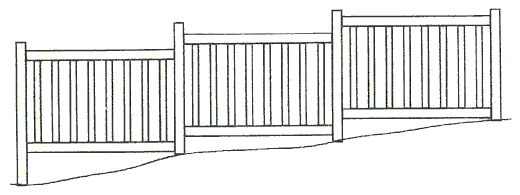
Racking Method – 10° or less
With the racking method, the horizontal rails will follow the sloping terrain. Most fence styles will rack naturally up to 10° (or 2′ rise per foot) without enlarging picket or rail holes. Refer to the natural racking chart to determine which styles will rack naturally.
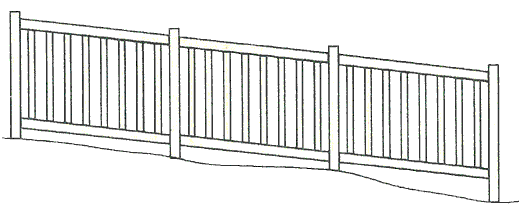
Natural Racking Chart
|
Fence Style |
Maximum Slope / Rise foot |
Maximum Angle |
| Contemporary |
2″ |
10° |
| Traditional | Will rack indefinitely, see note below. | |
| Post & Rail |
2″ with 8′ long rail |
10° |
| Privacy |
6 3/4″ |
35° |
Note: on severe slopes it is recommended that end posts be used and field cut to achieve proper rail positioning. If more rack is required, rail and picket holes will have to be enlarged. On severe slopes the rails and pickets may need to be cut. Hole enlargement can be done with a file or saber saw.
Racking Method – 10° or greater
When installing a fence on a slope that is greater than 10 degrees, it is necessary to enlarge the holes in the posts and rails. It is also necessary to miter the rails and pickets to allow for the angle. Refer to the maximum slope chart for various fence styles. Posts must be closer together when measured with a level string line to attain even picket spacing at end of fence sections.
|
Fence Style |
Maximum Slope / Rise foot |
Maximum Angle |
| Contemporary |
6 3/4′ |
35° |
| Traditional |
6 5/16′ |
32° |
| Post & Rail |
6 3/4′ |
35° |
| Privacy |
6 3/4″ |
35° |
SPECIAL NOTE: SOCKET GATES WILL NOT RACK
To determine the hole enlargement size, first calculate the slope rise / foot or the angle of the slope. Refer to the diagram and examples.
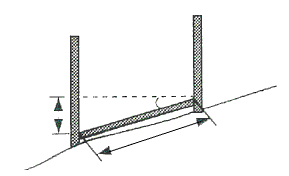
1. Measure section length in inches.
2. Determine section rise by using line level and measuring vertical rise (measure rise in inches).
3. Divide rise by section length to get rise per inch.
4. Multiply by 12 to determine rise per foot.
5. Once you have determined the rise per foot or angle, refer to the hole enlargement size chart.
EXAMPLE: 24″ rise (divided) 96″ length = 25 rise per inch = 3″ rise per foot.
|
Rise Per Foot |
7/8 x 1 1/2″ Picket |
7/8 x 3″ Picket |
2 x 4″ Rail |
Angle |
|
2″ or less |
1 1/2″ |
3″ |
3 1/2″ |
10° |
|
3″ |
1 9/16″ |
3 1/8″ |
3 5/8″ |
15° |
|
4″ |
1 5/8″ |
3 1/4″ |
3 13/13″ |
20° |
|
5″ |
1 11/16″ |
3 3/8″ |
3 15/16″ |
25° |
|
6″ |
1 13/16″ |
3 1/2″ |
4 1/8″ |
30° |
|
7″ |
1 15/16″ |
3 3/4″ |
4 3/8″ |
35° |
Enlarge Holes
Use a saber saw to enlarge rail hole in post example: Material removed from rail hole for slope 10° or greater.
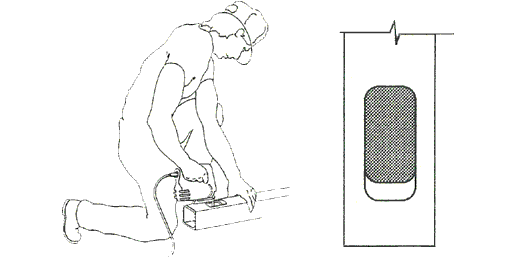
Post Selection
For a steady sloping terrain, use end post or blank posts. Mark posts and make holes on opposite side to allow rail alignment on both sides of posts.
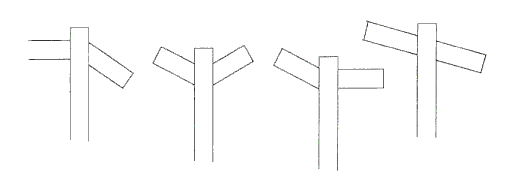
For variable sloping terrain, use line posts and enlarge rail holes.
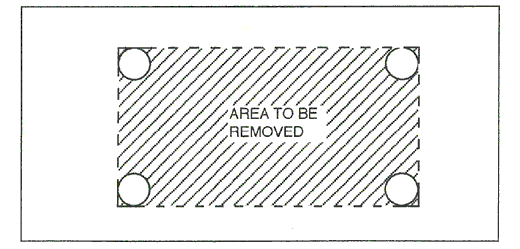
Determine hole size required.
Mark hole cut out on post in correct location.
Drill 4 holes in corners, same as radius required.
Cut along straight lines with a saber saw.
Clean holes with a file.

